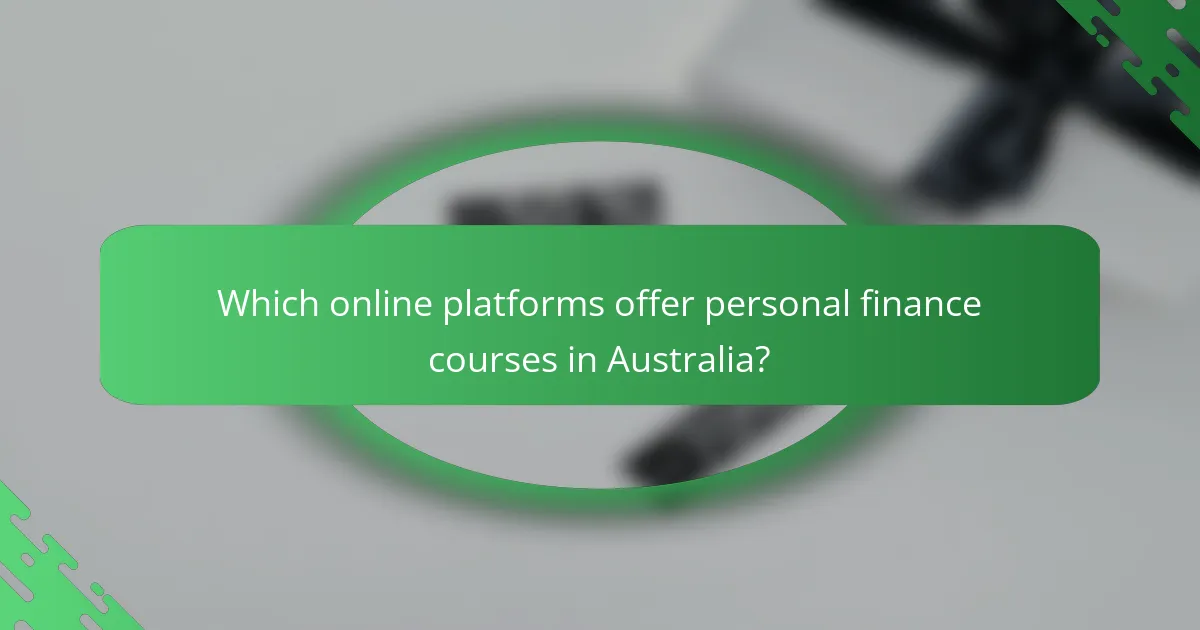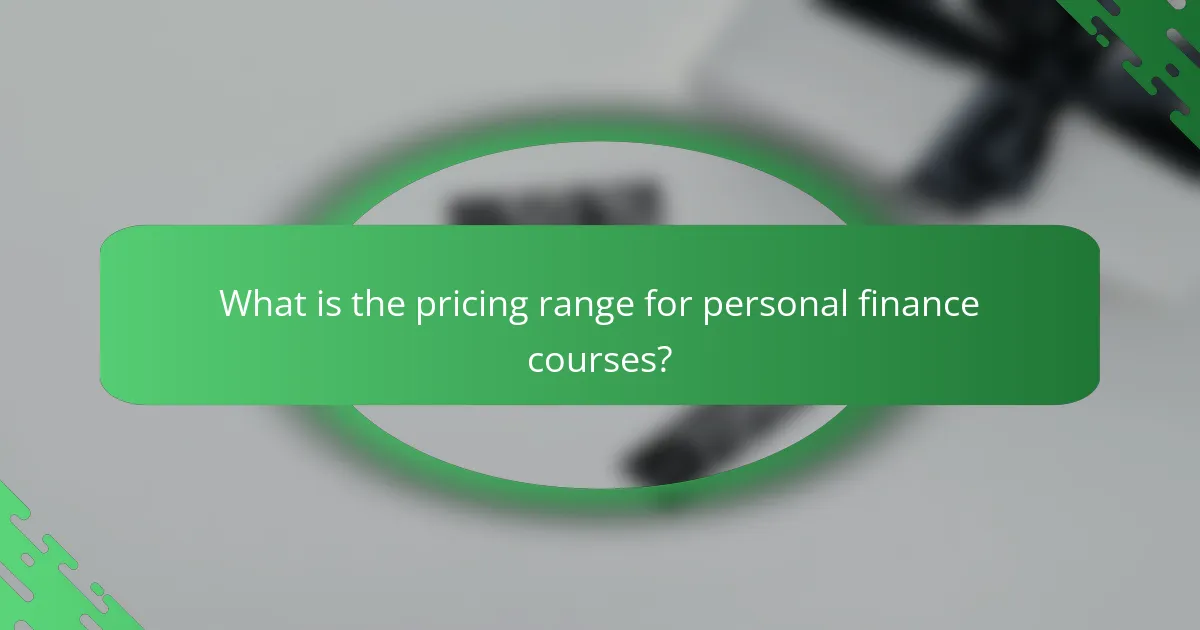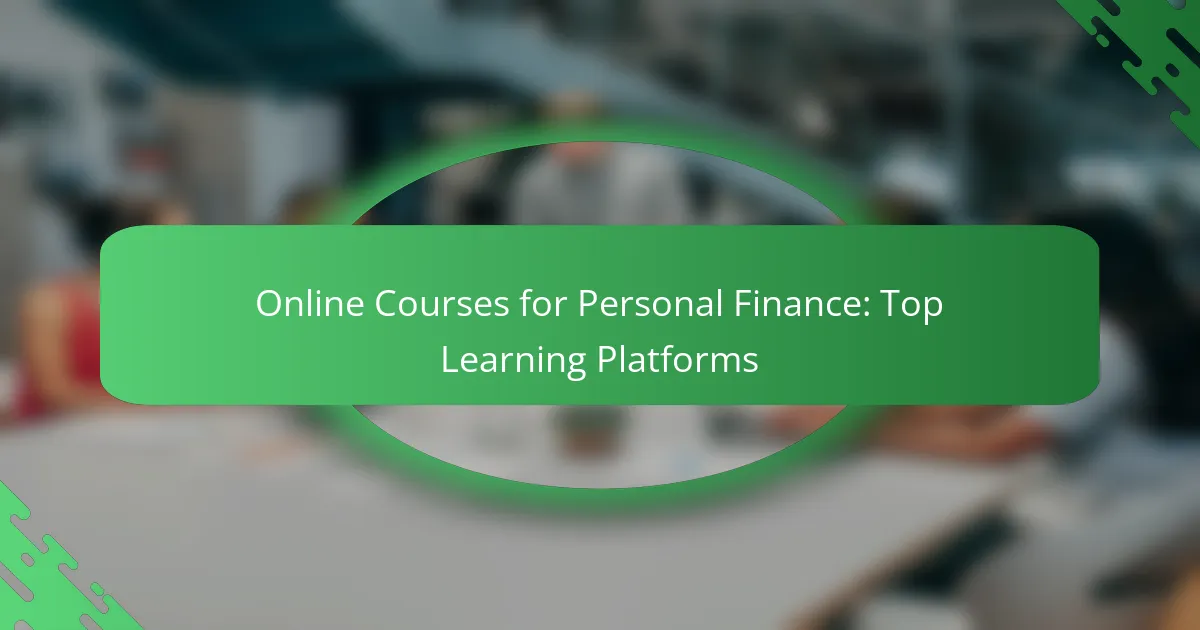In today’s fast-paced world, enhancing your financial literacy is essential, and online courses offer a convenient way to learn about personal finance. Various platforms provide tailored courses in budgeting, investing, and financial planning, making it easier for individuals to improve their financial skills. By considering factors such as course content, instructor credentials, and user reviews, you can find the ideal course to meet your personal finance goals.

Which online platforms offer personal finance courses in Australia?
Several online platforms provide personal finance courses tailored for learners in Australia. These platforms offer a variety of courses that cover budgeting, investing, and financial planning, making it easier for individuals to enhance their financial literacy.
Coursera
Coursera partners with universities and organizations to offer a wide range of personal finance courses. Users can access courses from reputable institutions, often for free or at a low cost, with the option to pay for a certificate upon completion. Courses typically cover topics such as financial planning, investment strategies, and retirement savings.
For Australian learners, Coursera often features courses that align with local financial regulations and practices, making the content relevant and applicable. Look for courses that offer hands-on projects to apply what you learn in real-world scenarios.
Udemy
Udemy is known for its extensive library of personal finance courses, which are created by individual instructors. This platform allows users to choose courses based on their specific interests, such as debt management or stock market investing. Prices vary widely, often ranging from AUD 20 to AUD 200, depending on the course length and depth.
When selecting a course on Udemy, check the ratings and reviews to ensure quality. Many courses come with lifetime access, allowing you to revisit the material whenever needed, which is beneficial for ongoing learning.
edX
edX offers high-quality courses from top universities and institutions, focusing on personal finance fundamentals and advanced topics. Many courses are free to audit, with a fee required for certification. This platform is particularly suitable for those seeking a structured learning experience with academic rigor.
Australian learners can benefit from courses that incorporate local case studies and financial regulations. Look for programs that offer interactive components, such as quizzes and discussion forums, to enhance your understanding.
Skillshare
Skillshare focuses on creative and practical skills, including personal finance. Courses are typically shorter and more focused, making them ideal for quick learning. Subscription-based access allows users to explore multiple courses for a monthly fee, usually around AUD 20.
While Skillshare may not offer as comprehensive a curriculum as other platforms, it provides valuable insights into specific areas like budgeting apps or financial goal-setting. Engage with the community through projects and feedback to deepen your learning experience.
LinkedIn Learning
LinkedIn Learning provides a professional approach to personal finance education, with courses designed to enhance career-related financial skills. Subscription access allows users to explore a variety of topics, including personal budgeting and investment basics, for a monthly fee of around AUD 40.
Courses often include real-world examples and case studies relevant to Australian professionals. Take advantage of the platform’s integration with LinkedIn to showcase completed courses on your profile, enhancing your professional credibility.

What are the top features of personal finance courses?
The top features of personal finance courses include interactive content, expert instructors, flexible scheduling, and certification options. These elements enhance the learning experience, making it easier for individuals to grasp essential financial concepts and apply them effectively in real life.
Interactive content
Interactive content in personal finance courses often includes quizzes, simulations, and engaging multimedia presentations. This hands-on approach helps learners actively participate in their education, reinforcing concepts through practical application.
For example, a budgeting simulation might allow students to allocate a virtual income to various expenses, helping them understand real-world financial decision-making. Look for courses that incorporate these interactive elements to enhance retention and understanding.
Expert instructors
Courses led by expert instructors provide valuable insights and real-world experience. Instructors with backgrounds in finance, accounting, or economics can offer practical advice and answer complex questions that arise during the learning process.
When selecting a course, check the credentials of the instructors. Look for those who have relevant degrees or extensive experience in personal finance to ensure you receive high-quality education.
Flexible scheduling
Flexible scheduling allows learners to study at their own pace, accommodating busy lifestyles. Many online platforms offer on-demand courses that can be accessed anytime, making it easier to fit learning into your schedule.
Consider platforms that provide a mix of live sessions and recorded content. This way, you can participate in real-time discussions while also having the option to review materials later.
Certification options
Certification options can enhance your credentials and demonstrate your commitment to personal finance education. Many courses offer certificates upon completion, which can be beneficial for career advancement or personal development.
When evaluating courses, check if the certification is recognized by employers or relevant professional organizations. This can add significant value to your learning experience and improve your job prospects in finance-related fields.

How do I choose the best personal finance course?
To choose the best personal finance course, consider the course content, instructor credentials, user reviews, and pricing. Evaluating these factors will help you find a course that meets your learning needs and financial goals.
Assess course content
Start by reviewing the course syllabus to ensure it covers essential topics like budgeting, investing, debt management, and retirement planning. Look for courses that offer practical applications and real-world scenarios to enhance your understanding.
Consider whether the course provides resources such as worksheets, quizzes, or interactive tools. These elements can significantly improve your learning experience and retention of the material.
Check instructor credentials
Investigate the qualifications of the course instructor. Look for professionals with relevant experience in personal finance, such as certified financial planners or educators with a strong background in finance-related subjects.
Instructor credibility can greatly influence the quality of the course. Research their professional history, educational background, and any published works to gauge their expertise.
Read user reviews
User reviews can provide valuable insights into the course’s effectiveness and overall satisfaction. Check multiple platforms to gather a range of opinions, focusing on feedback regarding the course content and instructor engagement.
Pay attention to comments about the course’s applicability to real-life situations and whether it has helped others achieve their financial goals. This information can guide your decision-making process.
Compare pricing
Pricing for personal finance courses can vary widely, from free resources to several hundred dollars. Determine your budget and consider what you are willing to invest in your financial education.
Look for courses that offer a money-back guarantee or free trials, allowing you to assess the content before fully committing. This can help you avoid spending money on a course that doesn’t meet your expectations.

What is the pricing range for personal finance courses?
The pricing range for personal finance courses varies significantly, typically falling between free options and several hundred dollars. Factors influencing costs include course length, content depth, and the platform’s reputation.
Free courses available
Many platforms offer free personal finance courses, making financial education accessible to everyone. Websites like Coursera, Khan Academy, and Udemy often feature introductory courses at no cost.
While these free courses can provide valuable insights, they may lack comprehensive content or personalized support. It’s essential to assess the course’s quality and user reviews before enrolling.
Average cost: $50 – $300
Most personal finance courses range from approximately $50 to $300, depending on the provider and course complexity. Basic courses focusing on budgeting or saving strategies tend to be on the lower end of this spectrum.
More advanced courses, especially those covering investing or retirement planning, can reach the higher end. Consider your learning goals and budget when selecting a course.
Subscription models
Some platforms offer subscription models, allowing access to multiple courses for a monthly fee. This can be a cost-effective option if you plan to take several courses over time.
For instance, platforms like Skillshare or LinkedIn Learning charge a monthly subscription, typically around $20 to $30, providing access to a wide range of personal finance topics. Evaluate the available courses to ensure the subscription meets your educational needs.

What are the benefits of online personal finance education?
Online personal finance education offers flexibility and a wealth of resources that can help individuals manage their finances more effectively. By learning at their own pace, students can grasp essential concepts without the pressure of a traditional classroom setting.
Convenience and accessibility
Online personal finance courses provide unparalleled convenience, allowing learners to access materials anytime and anywhere with an internet connection. This flexibility is particularly beneficial for busy professionals or students who may struggle to attend in-person classes.
Many platforms offer courses that can be completed in a few hours to several weeks, accommodating various schedules. For instance, platforms like Coursera or Udemy allow learners to choose from short modules or comprehensive programs, making it easier to fit education into daily routines.
Additionally, online courses often include multimedia resources such as videos, quizzes, and interactive tools, enhancing the learning experience. This variety caters to different learning styles, ensuring that students can engage with the material in a way that suits them best.
